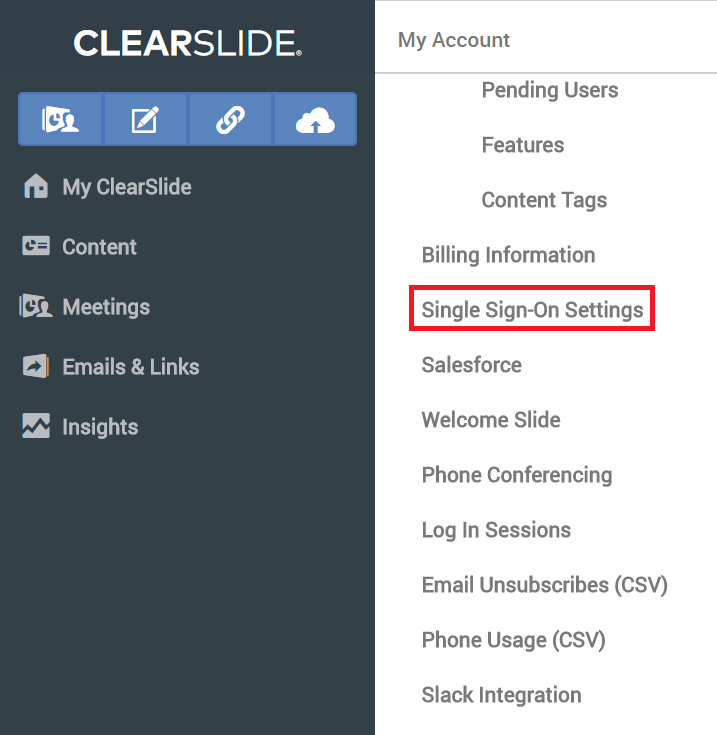Configuring SAML SSO for ClearSlide
These steps will guide you through setting up the single sign-on functionality between ADSelfService Plus and ClearSlide
Prerequisite
-
Log in to ADSelfService Plus as an administrator.
- Navigate to Configuration → Self-Service → Password Sync/Single Sign On → Add Application, and select ClearSlide from the applications displayed.
Note: You can also find ClearSlide application that you need from the search bar located in the left pane or the alphabet wise navigation option in the right pane.
-
Click IdP details in the top-right corner of the screen.
-
In the pop-up screen that appears, note down the values of Login URL and Logout URL. and download the sso certificate by clicking Download Certificate

ClearSlide (Service Provider) configuration steps
-
Now, log in to your ClearSlide administrator account.
-
Click on your account name in lower-left corner and select My Account.
-
Under Admin Only Options, click Single Sign-On Settings.

-
In the Single Sign-On Provider drop-down list, select SAML 2.0 Provider.

-
Select options Automatically create user accounts and Require Single Sign-On for all users based on your preference.
-
Note down the value provided in the Custom Login URL. This value will serve as the sub domain name while configuring ClearSlide in ADSelfService Plus. We will need this value in a later step.

-
In the Single Sign-Out URL field, enter the Logout URL value you had saved earlier in Step 4 of Prerequisite.
-
Scroll down to Your SAML Provider Configurations section.
-
In the SAML Provider Endpoint and SAML Provider Entity ID fields, enter the Login URL value that you had saved earlier in Step 4 of Prerequisite.

-
In the x509 Certificate field, paste the certificate (PEM) file content you had copied earlier in Step 4 of Prerequisite.
-
Click Save.
ADSelfService Plus (Identity Provider) configuration steps
-
Now, switch to ADSelfService Plus’ ClearSlide configuration page.
-
Enter the Application Name and Description.
-
In the Assign Policies field, select the policies for which SSO need to be enabled.
Note:ADSelfService Plus allows you to create OU and group-based policies for your AD domains. To create a policy, go to Configuration → Self-Service → Policy Configuration → Add New Policy.
-
Select Enable Single Sign-On.
-
Enter the Domain Name of your ClearSlide account. For example, if you use johndoe@thinktodaytech.com to log in to ClearSlide, then thinktodaytech.com is the domain name.
-
In the SP Identifier field, enter the value you had saved in Step 6 of ClearSlide configuration.
-
Enter the Assertion Consumer Service URL provided by your application service provider in the Assertion Consumer Service URL field. If required, click the + button next to the text field to add multiple Assertion Consumer URLs. These values can be found in the application's SSO configuration page or metadata. Please reach out to your application's support team if you are having trouble locating the Assertion Consumer Service URL in your application's user interface or metadata.
-
In the Name ID Format field, choose the format for the user login attribute value specific to the application.
Note: Use Unspecified as the default option if you are unsure about the format of the login attribute value used by the application.
-
Click Add Application.
Your users should now be able to sign in to ClearSlide through ADSelfService Plus.
Note:
For ClearSlide, both IdP-initiated and SP-initiated flows are supported.




